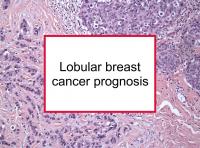Lobular and ductal breast cancer are the two most common histological types of breast cancer. Up to 15% of U.S. invasive breast cancers are classified as lobular, which refers to the fact that the cancer developed in the cells that line the milk-producing glands (lobules) of the breast. Ductal breast cancer forms in the milk ducts.
Until recently, most studies have concluded that lobular breast cancer can be treated as successfully as ductal breast cancer using the same treatments (as appropriate based on hormone receptor status and other tumor characteristics). In fact, it has been suggested that lobular breast cancer has a better prognosis than ductal breast cancer based on its less aggressive tumor characteristics. Now a new study has reported that lobular breast cancer does not have a better outcome than ductal breast cancer, despite its apparently favorable biological pattern.
Differences between lobular and ductal breast cancer
Women with lobular breast cancer have a higher average age at diagnosis compared to those with ductal breast cancer. Compared to women who have never given birth, mothers have a lower risk of ductal, but not lobular breast cancer. Use of combined HRT (containing both estrogen and progesterone) increases the risk of lobular breast cancer more than ductal breast cancer. Certain foods also appear to increase the risk of lobular breast cancer more than ductal breast cancer. Lobular breast cancer is more likely to have a hereditary component. In fact, lobular breast cancer patients are more likely to have a father diagnosed with cancer, especially prostate cancer.
Lobular breast cancer is more likely to be multifocal (more than one tumor per breast), bilateral (diagnosed in both breasts at the same time), and hormone receptor positive (ER+/PR+) than ductal breast cancer. It is rare for lobular breast cancer to be HER2 positive (HER2+). Lobular breast cancer tends to be diagnosed at a later stage and larger tumor size than ductal breast cancer. Lobular tumors have a tendency to metastasize to more axillary lymph nodes than ductal tumors of the same grade or size. Women with lobular breast cancer are less likely to obtain clean surgical margins after a lumpectomy than those with ductal breast cancer. Women with lobular breast cancer are also more likely to get ovarian and gastric (stomach) metastases than those with other types of breast cancer.
Lobular and ductal breast cancer have different outcomes
The study referenced at the beginning of this news article was designed to investigate the differences between lobular and ductal breast cancer, including survival outcomes. To conduct the study, the authors analyzed data from 3,749 consecutive cases of invasive breast cancer treated between 1995 and 2008. The median age at diagnosis was 61 years. Included were 445 lobular, 3,021 ductal, 149 mixed ductal/lobular, and 134 other histological types. The women were followed for a median of 77 months.
Generally speaking, lobular cases had larger tumor size and more frequent positive lymph nodes compared to the ductal cases. Lobular cases typically had intermediate tumor grade, low Ki-67 (proliferation), positive estrogen receptor status (ER+), and negative HER2 status (HER2-). The rate of mastectomy was higher for lobular (45%) than ductal (37%) cases.
Breast cancer-free survival was comparable for lobular (81.4%) and ductal (82.1%) cases during follow up. Overall survival rates (lobular: 82.8% compared to ductal: 84.6%) were also similar (the differences were not statistically significant). The rates of local recurrences and distant metastases were 3.3% and 11.2% for lobular compared to 5.9% and 7.4% for ductal cases. Sites of first distant relapse were similar for both types.
The median time to relapse was three months longer for the women with lobular (38.3 months) compared to ductal (35.23 months) disease. Among women who relapsed, median survival was 16.5 months for lobular compared to 22.2 months for ductal cases. Overall survival was consistently worse for lobular cases, when compared according to luminal A (lobular: 86.9% compared to ductal: 93.5%), luminal B (70.4%, 88.5%), and triple negative subtypes (50%, 73.1%). No differences in overall survival were found based on age at diagnosis, tumor size, hormone receptor and lymph node status, apart from N> 3 (extensive lymph node involvement) lobular patients, in whom somewhat worse prognosis (55.6 vs. 60.2%) was seen. The authors conclude that women in the study with lobular breast cancer did not have a better outcome than ductal patients, despite an apparently more favorable biological pattern.
